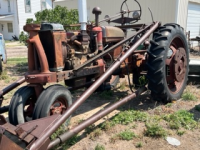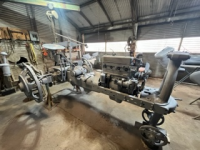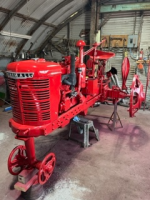You are using an out of date browser. It may not display this or other websites correctly.
You should upgrade or use an alternative browser.
You should upgrade or use an alternative browser.
Motor Heads: Cars, Trucks, Tractors & Hvy Equip.
Welcome to the Precious Metals Bug Forums
Welcome to the PMBug forums - a watering hole for folks interested in gold, silver, precious metals, sound money, investing, market and economic news, central bank monetary policies, politics and more.
Why not register an account and join the discussions? When you register an account and log in, you may enjoy additional benefits including no Google ads, market data/charts, access to trade/barter with the community and much more. Registering an account is free - you have nothing to lose!
- Messages
- 4,907
- Reaction score
- 4,918
- Points
- 308
- Messages
- 32,964
- Reaction score
- 5,620
- Points
- 288
Here's how a war created the GREATEST RACING DYNASTY in history!
Jun 10, 2025 #VINwiki #BentleyBoys #roaring20sGreg Porter shares his insight into the era that precipitated the racing lives of the Bentley boys in the 1920s
9:58
- Messages
- 32,964
- Reaction score
- 5,620
- Points
- 288
- Messages
- 4,907
- Reaction score
- 4,918
- Points
- 308
^^^^
Looks like a golf-course tractor to me.
A number of makers had them, aside from the traditional greens-equipment makers (Jacobsen and Toro). Ford had a smaller-wheeled version of their 1960s midsize tractor...forget the series name or model; but back in the day, they were commonplace with lighter-duty users. The course I worked at had two - a grownup-size 1969 model, with a front-loader on it; and the smaller-wheeled one, dual rear wheels, aimed at groundskeeping. Both had the overhead-valve three-cylinder engines that, frankly, were crap.
Alongside those, we had a Ford 8N and a Golden Harvester. Both were fours - the 8N a flathead, the Golden Harvester with the new overhead-valve engine. Both had a great-deal more torque than the "new" threes on those two 1960s models.
It didn't surprise me when in 1979, Ford just abandoned the tractor market. By that time, they had stopped making gasoline tractors, and IIRC, they were contracting out their diesel engines. Farmers remembered how unsuitable those high-revving-but-gutless three-cylinder jobs were.
28 hp out of a tractor is not a bad figure. IIRC, the 8N only made 25 hp. Be interesting to see how the two worked under load.
Ford didn't abandon the tractor market. They simply teamed up with New Holland.
My New Holland 4630 (55 hp) was built in 1997 and says "Ford" right on it.
Look just over the front tire and just under the "4630".
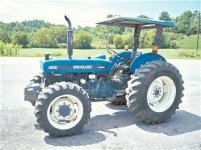
Sold their line to New Holland.
They went to put a happy face on it - that's how it goes when a major maker leaves a market and sells their designs. When GMC sold its heavy-truck line and designs to Volvo, they didn't call it abandoning the market - it was "Teaming up" with "White Motors" (bankrupt from 1979; the company was sold to Volvo as Volvo-White) and creating "A new brand - WhiteGMC." Which lasted about six years, before just becoming Volvo. Which it is to this day. A lot of both White and GMC designs were incorporated, but that's faded with time - the GMC-Volvo purchase happened in 1990; 35 years ago.
Ford wanted out. This wasn't surprising - Ford, the company, always had a love-hate relationship with farm equipment. Henry Ford wanted to make tractors; but directors of his car company did not. This was one of the few times the stood up to Old Henry - and that led to H. Ford & Son Tractor Works, marketed as Fordson.
With time, Fordson was absorbed into Ford, but even that brought more grief. There was the Ford 8N lawsuit, between Harry Ferguson, inventor of the Three-Point Hitch, and Henry Ford, who put it on his 8N, promised Ferguson a royalty, and then told Harry to pound salt. That suit carried on for years, and in the end, cost Ford $9 million and a lot of lost goodwill.
That was in 1952. Thirty years later, the Ford tractor line, such as it was, was mostly rebranded imported products. Ford was tired of the business - the family, the directors. New Holland could have what was left of it.
They went to put a happy face on it - that's how it goes when a major maker leaves a market and sells their designs. When GMC sold its heavy-truck line and designs to Volvo, they didn't call it abandoning the market - it was "Teaming up" with "White Motors" (bankrupt from 1979; the company was sold to Volvo as Volvo-White) and creating "A new brand - WhiteGMC." Which lasted about six years, before just becoming Volvo. Which it is to this day. A lot of both White and GMC designs were incorporated, but that's faded with time - the GMC-Volvo purchase happened in 1990; 35 years ago.
Ford wanted out. This wasn't surprising - Ford, the company, always had a love-hate relationship with farm equipment. Henry Ford wanted to make tractors; but directors of his car company did not. This was one of the few times the stood up to Old Henry - and that led to H. Ford & Son Tractor Works, marketed as Fordson.
With time, Fordson was absorbed into Ford, but even that brought more grief. There was the Ford 8N lawsuit, between Harry Ferguson, inventor of the Three-Point Hitch, and Henry Ford, who put it on his 8N, promised Ferguson a royalty, and then told Harry to pound salt. That suit carried on for years, and in the end, cost Ford $9 million and a lot of lost goodwill.
That was in 1952. Thirty years later, the Ford tractor line, such as it was, was mostly rebranded imported products. Ford was tired of the business - the family, the directors. New Holland could have what was left of it.
Last edited:
- Messages
- 4,907
- Reaction score
- 4,918
- Points
- 308
Sold their line to New Holland.
They went to put a happy face on it - that's how it goes when a major maker leaves a market and sells their designs. When GMC sold its heavy-truck line and designs to Volvo, they didn't call it abandoning the market - it was "Teaming up" with "White Motors" (bankrupt from 1979; the company was sold to Volvo as Volvo-White) and creating "A new brand - WhiteGMC." Which lasted about six years, before just becoming Volvo. Which it is to this day. A lot of both White and GMC designs were incorporated, but that's faded with time - the GMC-Volvo purchase happened in 1990; 35 years ago.
Ford wanted out. This wasn't surprising - Ford, the company, always had a love-hate relationship with farm equipment. Henry Ford wanted to make tractors; but directors of his car company did not. This was one of the few times the stood up to Old Henry - and that led to H. Ford & Son Tractor Works, marketed as Fordson.
With time, Fordson was absorbed into Ford, but even that brought more grief. There was the Ford 8N lawsuit, between Harry Ferguson, inventor of the Three-Point Hitch, and Henry Ford, who put it on his 8N, promised Ferguson a royalty, and then told Harry to pound salt. That suit carried on for years, and in the end, cost Ford $9 million and a lot of lost goodwill.
That was in 1952. Thirty years later, the Ford tractor line, such as it was, was mostly rebranded imported products. Ford was tired of the business - the family, the directors. New Holland could have what was left of it.
Still says "Ford" on it and they kept the Ford model numbers.

I wouldn't buy a new though. Mine was built in the UK. The new ones are coming out of India.
- Messages
- 32,964
- Reaction score
- 5,620
- Points
- 288
Great Museums Of Rural Life And Old-Time Power At The Tuckahoe Steam & Gas Show In Maryland!
Jun 20, 2025 #classictractor #tractor #classictractorfeverClassic Tractor Fever was on the road at the 50th Tuckahoe Steam and Gas Association Show. In addition to outstanding steam engines and classic farm tractors, Tuckahoe offers a number of museums on the grounds that fascinate people, and give a glimpse of American life in the past. Andy Koch of the Tuckahoe club gave us some insights. More on the Association and the show at the website: www.TuckahoeSteam.org
7:01
- Messages
- 32,964
- Reaction score
- 5,620
- Points
- 288
A Classic Farm Tractor With A British Accent! Say Cheerio To The 1969 BMC Nuffield Tractor!
Jun 16, 2025 #classictractor #tractor #classictractorfeverLots to see at the Grease, Steam and Rust Show (GSR) in McConnellsburg, Pennsylvania each fall. When we were there, we saw this tractor - not often seen in the USA. We visited with Dave Leamer, who owns this BMC Nuffield and it is a real beaut! Enjoy the story!
7:59
- Messages
- 32,964
- Reaction score
- 5,620
- Points
- 288
I had a TJ.
Basically it was a good rig. The coil springs (on beam axles, which is, for off-roading, a better way) gave a great ride. A LOT of work went into balancing the CJ7-derived chassis, with much success. And Chrysler in those years was at the top of its game - quality-control was better than it ever had been, morale in the company was high, profits were there. And the TJ Wrangler was AFFORDABLE. I got my stripper, 1998 model-year closeout, for $10k.
There were two problems. First, and less important, the front prop-shaft had no disconnect. Locking front hubs were not available. The engineers did work to reduce the front-axle drag when unloaded, but there was only so much you could do. I bought the TJ when I was new to Conrail and was working in a major rail yard, often having to use my own car to get into rough places to do switching.
As always happens, I bought the rig, and then immediately got a promotion, and a seat in engineer's school. That entailed two months' commuting to Pittsburgh (on Interstates) followed by being bounced between Cleveland and Buffalo. On Interstates.
Not being able to disconnect the front axle, for all that good-weather highway riding, I pulled the front shaft. And what a project THAT was - intentionally or not. A factory skid plate that served as a motor mount had to be partially removed to get to the transfer-case boss.
That was the lesser problem. The REAL irritation to me was, that damn massive dashboard and those airbags.
After two years, I sold the thing - for what I paid for it. By then Daimler owned Chrysler and quality, and customer-care, was sliding into the toilet. My TJ had the AMC-designed pushrod four - far better than the OHC four designed for the Neon, that Daimler ordered stuffed into new Wranglers.
The beginning of the end. A few years later, vacationing in Las Vegas, I found a YJ, equipped similarly to my TJ, and bought it and drove it home. With the more-traditional dashboard, no airbags, it was a much more pleasing driving experience. The leaf springs were rougher, but not anything like the old CJ7 - it was much closer to the later TJ in driving. I was suited, and kept it ten years. Only my serial relocations, made it impractical to keep - I sold it in Wisconsin.
Wish I had it now.
Glad Steve likes his Jeep. Hard for me to get my head around how a TJ Jeep is an old Jeep.
Basically it was a good rig. The coil springs (on beam axles, which is, for off-roading, a better way) gave a great ride. A LOT of work went into balancing the CJ7-derived chassis, with much success. And Chrysler in those years was at the top of its game - quality-control was better than it ever had been, morale in the company was high, profits were there. And the TJ Wrangler was AFFORDABLE. I got my stripper, 1998 model-year closeout, for $10k.
There were two problems. First, and less important, the front prop-shaft had no disconnect. Locking front hubs were not available. The engineers did work to reduce the front-axle drag when unloaded, but there was only so much you could do. I bought the TJ when I was new to Conrail and was working in a major rail yard, often having to use my own car to get into rough places to do switching.
As always happens, I bought the rig, and then immediately got a promotion, and a seat in engineer's school. That entailed two months' commuting to Pittsburgh (on Interstates) followed by being bounced between Cleveland and Buffalo. On Interstates.
Not being able to disconnect the front axle, for all that good-weather highway riding, I pulled the front shaft. And what a project THAT was - intentionally or not. A factory skid plate that served as a motor mount had to be partially removed to get to the transfer-case boss.
That was the lesser problem. The REAL irritation to me was, that damn massive dashboard and those airbags.
After two years, I sold the thing - for what I paid for it. By then Daimler owned Chrysler and quality, and customer-care, was sliding into the toilet. My TJ had the AMC-designed pushrod four - far better than the OHC four designed for the Neon, that Daimler ordered stuffed into new Wranglers.
The beginning of the end. A few years later, vacationing in Las Vegas, I found a YJ, equipped similarly to my TJ, and bought it and drove it home. With the more-traditional dashboard, no airbags, it was a much more pleasing driving experience. The leaf springs were rougher, but not anything like the old CJ7 - it was much closer to the later TJ in driving. I was suited, and kept it ten years. Only my serial relocations, made it impractical to keep - I sold it in Wisconsin.
Wish I had it now.
Glad Steve likes his Jeep. Hard for me to get my head around how a TJ Jeep is an old Jeep.
The damn video made me think.
His, like mine, is a 1998. Geez, that's a new Jeep...whoa, hit the brakes, Slick. That thing's 27 years old.
TWENTY-SEVEN YEARS.
Judas Priest. When I bought my 1998 TJ, NEW, a 27-year-old Jeep would be a 1971 CJ. The first year of American Motors ownership, and still with the 1950s Willys engineering...an F-head four, open top, shorter nose of those years. THAT would have been truly primitive - only suitable for farm duty.
So now the TJ is of that age. And it's wearing it well - it's a lot more desirable than the overpriced, fragile, current crop of Wranglers - made by a Belgian company that doesn't understand them engineered under contract and over the phone from India.
And while I could have gotten a 1971 CJ for about $1000, in good shape, that TJ today would easily go for close to $20k.
His, like mine, is a 1998. Geez, that's a new Jeep...whoa, hit the brakes, Slick. That thing's 27 years old.
TWENTY-SEVEN YEARS.
Judas Priest. When I bought my 1998 TJ, NEW, a 27-year-old Jeep would be a 1971 CJ. The first year of American Motors ownership, and still with the 1950s Willys engineering...an F-head four, open top, shorter nose of those years. THAT would have been truly primitive - only suitable for farm duty.
So now the TJ is of that age. And it's wearing it well - it's a lot more desirable than the overpriced, fragile, current crop of Wranglers - made by a Belgian company that doesn't understand them engineered under contract and over the phone from India.
And while I could have gotten a 1971 CJ for about $1000, in good shape, that TJ today would easily go for close to $20k.
- Messages
- 32,964
- Reaction score
- 5,620
- Points
- 288
What Were Hot Rod Cars Like Back In The 1950s? This Original Film Shows Just What It Was Really Like
What Were Hot Rod Cars Like Back In The 1950s? This Original Film- Messages
- 32,964
- Reaction score
- 5,620
- Points
- 288

Daimler Deepens Diesel Engine Focus, Boosts Investment - TT
Daimler Truck executives signaled a renewed focus on diesel powertrains at the company’s Capital Market Day 2025.
- Messages
- 32,964
- Reaction score
- 5,620
- Points
- 288
Born in the USSR: The Untold Story of a Legendary 4x4
Jul 20, 2025It started as a rugged military vehicle and became one of the most iconic off‑roaders in Soviet history.
In this documentary, we dive deep into the origins, design, and legacy of the vehicle that carried soldiers, hunters, and adventurers through mud, snow, and decades of history.
Discover how this Soviet 4x4 survived on the production line until 1972, how it was exported to 56 countries, and how it inspired versions built in Romania, North Korea, and beyond.
From secret prototypes to legendary off‑road feats — this is a story you’ve probably never heard before.
24:21
- Messages
- 32,964
- Reaction score
- 5,620
- Points
- 288
Never Seen This! Meet the YORK TURN O BOUT Classic Garden Tractor built in Oregon around 1950!
Jul 11, 2025 #classictractor #tractor #classictractorfeverThe late Jim McCracken of Oregon loved rare and unusual garden tractors. His York Turn O Bout machine, built in Oregon around 1950, featured two massive front wheels and a heavy front end. Two wheels at the back skitter around behind. It's awkward to drive and impractical to use -- but it's a rare piece of classic garden tractor history. Jim also loved to collect antique engines and vintage radios.
4:46
- Messages
- 32,964
- Reaction score
- 5,620
- Points
- 288
Rare And Valuable! It's A 1939 9N Ford Tractor With An Aluminum Hood!
Jul 18, 2025 #classictractor #tractor #classictractorfeverFord Fan Don Henley shares the story of one of the very rare aluminum hood Ford 9N tractors he has restored. The story goes that the 9N tractors were built very quickly and the quickest path to getting a hood on the tractor was to use aluminum -- so they did so in the early editions of the 9N. That makes these tractors rare -- and valuable! Don sold this tractor in the Fall Harvest Rest-O-Riginal Aumann Vintage Power Auction. You can learn more about upcoming auctions, or consign your tractor at their website: www.AumannVintagePower.com
4:03
- Messages
- 32,964
- Reaction score
- 5,620
- Points
- 288
Did You Know: Truncated Toronado's, The Short Oldsmobiles
Jul 10, 2025In this short 'Did You Know?' story we look at two alternative sisters of the Oldsmobile Toronado. The Toronado was a front wheel drive personal luxury from the 1960s, that could easily be stretched or shortened. Some stylists found the original design too big and designed a shorter and sportier version. Others simply cut off the front and rear overhang to make it a 'pusher' for other cars stuck in the snow!
4:31
I hate to be a Donnie Downer...but I gotta jump in. So much of history is being, not just rewritten, but upended. Up is down, night is day.Born in the USSR: The Untold Story of a Legendary 4x4
Jul 20, 2025
It started as a rugged military vehicle and became one of the most iconic off‑roaders in Soviet history.
In this documentary, we dive deep into the origins, design, and legacy of the vehicle that carried soldiers, hunters, and adventurers through mud, snow, and decades of history.
Discover how this Soviet 4x4 survived on the production line until 1972, how it was exported to 56 countries, and how it inspired versions built in Romania, North Korea, and beyond.
From secret prototypes to legendary off‑road feats — this is a story you’ve probably never heard before.
We almost got a version of the GAZ in the US in 1973. Nixon's henchmen were talking with CCCP ministers about "Most-Favored-Nation" trading status. You know...the same exalted trading status that Bubba Priapic later gave to China.
What is it with liberals (no matter the party; and yes, Nixon was a closet lib) that they're SO FASCINATED with (failed) Marxism? Nixon wanted to open up the USSR's motor industry. The government was ready - they had decided to market that thing, and their clone of a Fiat 124, as the Lada brand. "Lada" meaning "Beloved" in Russian.
In fact, they DID get import licenses from the Pierre Trudeau government in Canukistan; and that's how we know we dodged a bullet. Back in the 1980s and 1990s, dead Ladas on the shoulder of the QEW, on the road to Toronto, was not an uncommon sight. I'd seen about four inoperative ones - never anyone that was actually moving under its own power.
Worse than a Yugo.
A Soviet-era motorcycle WAS imported into the States - not sure if it came before the end of the USSR, but it was of that era. The Ural - which was a prewar BMW. The tooling came out of a BMW plant in what became East Germany, and was sent to Russia. No, it was not given willingly - Communists steal, and this whole factory was stolen as war booty. So the Soviets ramped it up, and did make some modifications - including a sidecar kit that has both rear-wheels driving.
That didn't improve the quality, which - to this day - is LOUSY.
The machine, no longer available without the sidecar, is mostly sold to crony-rentier Western playboys who pine for collectivist dictatorship...that's how you make money, chasing government rents! They buy them, they re-engineer them when between coed girlfriends, and sometimes take them out and marvel at how, this is what a BMW Boxer bike would look like, if they'd just kept it real.
The reality is, their engineering was garbage. Because their social-legal contract, Marxism, was garbage. I think it's truly remarkable that in 35 years they have been able to put so much dysfunction and cultural ugliness behind them; but to this day, mostly, they buy cars from Japanese or German companies.
- Messages
- 32,964
- Reaction score
- 5,620
- Points
- 288
The Ural - which was a prewar BMW
Not a bike guy so I had to look this up.

IMZ-Ural - Wikipedia
URAL GEAR UP LONG TERM OWNER REVIEW
Oct 18, 2021In this video, Overland Travel Adventures provides thoughts and insights on owning and adventuring on our Ural Gear Up. This is a 2017 Ural Gear Up. Such a fun cool and useful motorcycle!
15:09
BTW..........you have a way with words. You post made me smile. Hope you're still considering a book. I'd buy a copy in a heartbeat.
That's a long story. I put it on hold - not sure the direction I wanted to go; and also, I was getting into things I didn't understand. The background was a steam-tourist railroad, modeled on one that did exist. Does exist, but no longer with steam.BTW..........you have a way with words. You post made me smile. Hope you're still considering a book. I'd buy a copy in a heartbeat.
Trouble is, I had never run steam. I write of what I know...my protagonist, who lands there after his firing, starts out as Joe Railroad and gets his arse handed to him. I'm having one of my collegiate yuppie summer-hires, become an early-twenties playboy type who spent another summer running at the Cumbres & Toltec. Which does exist, northern New Mexico. The steam expert - and out of a moneyed family. A different class, and a playboy and ladies' man. Ohhh, they are gonna CLASH.....
I had decided to carry my halting spurts of an attempt on Substack, but Substack, like an Apple computer, doesn't have logical instructions. I have an account. How to manage access, I haven't learned. Do I have to pay $$ to get that feature?
I keep telling myself, this is the season - too hot to be outdoors - but always, things pop up. I need to be in the gym and the range, too...even those sometimes get put aside. Today it's doctors and laundry.
On the thread I started, I'll put updates if/as they come.
January 1974.
The old man bought a 1973 Gran Torino to replace my mother's car. Air conditioning, 351-C V8, vinyl top.
Price, $3200. Discounted a grand, because it was the previous year's model. They were that panicked to get the old inventory off the lot. Not like today, where you can still find 2023 models rotting on the dealers' lots.
- Messages
- 32,964
- Reaction score
- 5,620
- Points
- 288

MCG Executive Briefing for July 21, 2025 - Mac's Motor City Garage.com
Broad Arrow Auctions will host its first sale in tandem with the Concours at Wynn Las Vegas on October 31. Get all the latest automotive news in the Executive Briefing. Today’s Headlines: + According to a letter sent to … Continue reading →
 macsmotorcitygarage.com
macsmotorcitygarage.com
- Messages
- 32,964
- Reaction score
- 5,620
- Points
- 288
Laura Farms Talks With Classic Tractor Fever About Her John Deere 4020 With Titan Tires!
Jun 27, 2025 #classictractor #tractor #classictractorfever
At the 2024 Farm Progress Show, we spent time at the Titan Tires exhibit and visited with well known Laura Farms of Nebraska. An enthusiastic advocate for real life agriculture, Laura was equally proud to share her FEVER for the 1965 John Deere 4020 she and her husband are putting back to work.
3:20
Jun 27, 2025 #classictractor #tractor #classictractorfever
At the 2024 Farm Progress Show, we spent time at the Titan Tires exhibit and visited with well known Laura Farms of Nebraska. An enthusiastic advocate for real life agriculture, Laura was equally proud to share her FEVER for the 1965 John Deere 4020 she and her husband are putting back to work.
3:20
Before they can order their destruction...they have to first, identify them.
Alinsky's Rules for Radicals. Identify the person (or object or type of object). Freeze it. Personalize it.
Destroy it.
Do you think really that farmers are somehow UNABLE to maintain modern farm tractors? They could, easily.
It's about CONTROLLING them. Through their Web-tethered tractors; through proprietary technologies that even the makers don't fully understand. Witness Stellantis' thousands of dissatisfied buyers with cars that can't be made to work right.
They're outlawing private farming by making it IMPOSSIBLE, with available "technology."
And what the MSLSD article does, is HIGHLIGHT those Refusniks who are getting around this, by using equipment that doesn't require permissions from the Mothership.
Alinsky's Rules for Radicals. Identify the person (or object or type of object). Freeze it. Personalize it.
Destroy it.
Do you think really that farmers are somehow UNABLE to maintain modern farm tractors? They could, easily.
It's about CONTROLLING them. Through their Web-tethered tractors; through proprietary technologies that even the makers don't fully understand. Witness Stellantis' thousands of dissatisfied buyers with cars that can't be made to work right.
They're outlawing private farming by making it IMPOSSIBLE, with available "technology."
And what the MSLSD article does, is HIGHLIGHT those Refusniks who are getting around this, by using equipment that doesn't require permissions from the Mothership.
- Messages
- 32,964
- Reaction score
- 5,620
- Points
- 288

MCG Executive Briefing for July 25, 2025 - Mac's Motor City Garage.com
Smokey Yunick’s ’68 Camaro racer will be sold at no reserve at the Bonhams|Cars Quail Auction. Get all the latest automotive news in the Executive Briefing. Today’s Headlines: + Toyota welcomed the announcement of a new trade deal between … Continue reading →
 macsmotorcitygarage.com
macsmotorcitygarage.com
Smokey had a lot of cars. Had a lot of experiments going, towards the end...he was a true redneck engineer. Started out running bootleg liquor, then cheating on NASCAR regs, and then doing legitimate racecar development.
He ran a regular Q&A on Popular Science Monthly. Later - late 1970s - other PS writers were detailing his breakthrough experiments with ceramic engine blocks - no cooling, ultra-efficient.
Meantime, out of his garage, he sold International Harvesters - and I think he was part owner in a VW dealership. He had the first Rabbit Diesel in Daytona Beach - and on PS, he did a review, separate from Jim Dunne's glowing puff-piece, where Smokey damned the thing for being a "stone."
"I can get along with 75 horsepower just fine. But that thing is ridiculous - and dangerous."
Later, my reading appetites shifted - and Smokey retired. He closed his "Best Damn Garage In Town" saying, publicly, "There are no more good mechanics."
My understanding is, his widow was working to turn his empty, closed garage into a Smokey Yunick museum; but before they got started with actual work, it burned down.
So. Smokey had any number of cars, including his test mules...and most disappeared. One survived? Wonder if the documents are right. Probably are - Smokey, sadly, is now forgotten.
He ran a regular Q&A on Popular Science Monthly. Later - late 1970s - other PS writers were detailing his breakthrough experiments with ceramic engine blocks - no cooling, ultra-efficient.
Meantime, out of his garage, he sold International Harvesters - and I think he was part owner in a VW dealership. He had the first Rabbit Diesel in Daytona Beach - and on PS, he did a review, separate from Jim Dunne's glowing puff-piece, where Smokey damned the thing for being a "stone."
"I can get along with 75 horsepower just fine. But that thing is ridiculous - and dangerous."
Later, my reading appetites shifted - and Smokey retired. He closed his "Best Damn Garage In Town" saying, publicly, "There are no more good mechanics."
My understanding is, his widow was working to turn his empty, closed garage into a Smokey Yunick museum; but before they got started with actual work, it burned down.
So. Smokey had any number of cars, including his test mules...and most disappeared. One survived? Wonder if the documents are right. Probably are - Smokey, sadly, is now forgotten.
- Messages
- 32,964
- Reaction score
- 5,620
- Points
- 288

MCG Executive Briefing for August 4, 2025 - Mac's Motor City Garage.com
A jury ordered Tesla to pay $243 million in a fatal crash that involved the carmaker’s Autopilot system. Get all the latest automotive news in the Executive Briefing. Today’s headlines: + Racing was suspended at Bonneville Speed Weeks after … Continue reading →
 macsmotorcitygarage.com
macsmotorcitygarage.com
We added another tractor to our antique tractor collection. Like our 1937 John Deere Model D, this 1943 Farmall H was in my father in law's yard collecting weeds and rust. This has been in my wife's family for several decades. We pulled it out of his yard and had it completely restored. We took it to the Tri-State Antique Engine and Thresher show in Bird City, Kansas this past weekend.
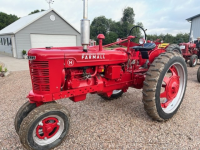

Took these three tractors to the local show this weekend. I ran the Farmall in the tractor drive on Friday, and father in law drove it in the parades on Saturday and Sunday. I drove the Deere MT in the parades; it had the M-series mounted plow attached for display purposes.
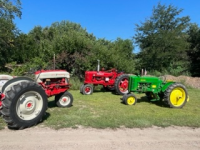
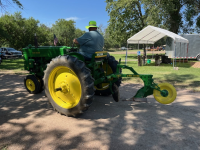
I used the Ford 961 Powermaster in the tractor pull; it has a good weight to horsepower ratio. I qualified to run in the 4000 pound weight class, and took third...
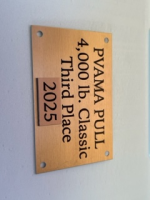


I used the Ford 961 Powermaster in the tractor pull; it has a good weight to horsepower ratio. I qualified to run in the 4000 pound weight class, and took third...

- Messages
- 32,964
- Reaction score
- 5,620
- Points
- 288

MCG Executive Briefing for August 22, 2025 - Mac's Motor City Garage.com
At $25.3 million, this 1961 Ferrari 250 GT California Spyder was a top seller in the Monterey car auctions. Get all the latest auto industry news in the Executive Briefing. Today’s headlines: + The global auto industry is holding … Continue reading →
 macsmotorcitygarage.com
macsmotorcitygarage.com
- Messages
- 32,964
- Reaction score
- 5,620
- Points
- 288
Did You Know? Donald Duck's 313 Car was an American Bantam!
Aug 25, 2025In this short 'Did You Know?' story we look at Donald Duck's daily. Whereas many other fictional Disney characters drive fake cars that are often inconsistent, Donald's ride is always the same. As it turns out, Donald's red 313 roadster has more to it than many fans think. It's been described as Belchfire Runabout or Duckatti Micro, and the real life counterpart is an American Bantam from the 1930's!
7:35
- Messages
- 32,964
- Reaction score
- 5,620
- Points
- 288
Handy? You Bet! It's A 1940 Allis Chalmers Model B At Home in Kentucky Farm Country!
Aug 25, 2025 #classictractor #tractor #classictractorfeverWe visit with Wayne Bennett about his Allis Chalmers model B that dates back to 1940. This is the kind of tractor that was super valuable for Kentucky farmers back in the day who were cultivating and growing tobacco, corn, wheat and other crops.
4:59
We lost a lot, with Big Ag corporatism.
When the collapse comes/continues, small landholders will be the ones propping up food production. If they're legally allowed to continue. And these small, light, inexpensive tractors are what they need - not $10-million high-tech monstrosities with 200 chips and a canbus. And operating systems that only those allowed, can see or diagnose.
We either reform or we starve. As these small affordable machines disappear, the likelihood that we'll have to revert to less-productive draft-animal use, or even HUMAN use (yeah, a subsistence-farmer pulling a rope over his shoulder while his wife guides the turnplow) becomes more likely.
When the collapse comes/continues, small landholders will be the ones propping up food production. If they're legally allowed to continue. And these small, light, inexpensive tractors are what they need - not $10-million high-tech monstrosities with 200 chips and a canbus. And operating systems that only those allowed, can see or diagnose.
We either reform or we starve. As these small affordable machines disappear, the likelihood that we'll have to revert to less-productive draft-animal use, or even HUMAN use (yeah, a subsistence-farmer pulling a rope over his shoulder while his wife guides the turnplow) becomes more likely.
- Messages
- 32,964
- Reaction score
- 5,620
- Points
- 288

Bollinger Acres
Bollinger Acres, Plumsteadville. 65 likes · 1 talking about this. Entrepreneur
 www.facebook.com
www.facebook.com
21 Year Old With A Fleet Of Brockways! (The Story Of Charlie Bollinger)
Aug 28, 2025In this video I have a special guest on the channel telling his story and his love for Brockway trucks. I had a lot of fun making this video and I hope you enjoy watching!
12:10
0:00 Where It All Began
1:55 Tri Axle Dream Come True
3:46 Working Class
5:12 Single Axle Comes Along
5:56 Another Addition
6:36 Dads Dodge
7:46 Inspirations
8:48 Future Plans
9:32 Timeline
10:11 Outro Talk
- Messages
- 32,964
- Reaction score
- 5,620
- Points
- 288

MCG Executive Briefing for August 29, 2025 - Mac's Motor City Garage.com
Ford is recalling nearly a half-million Ford Edge and Lincoln MKX vehicles to repair a brake fluid leak. Get all the latest auto industry news in the Executive Briefing. Today’s headlines: + General Motors is temporarily halting two production … Continue reading →
 macsmotorcitygarage.com
macsmotorcitygarage.com

